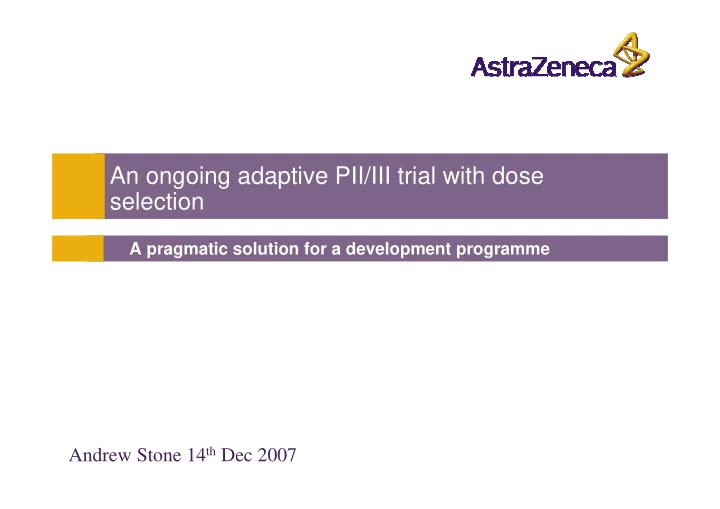

An ongoing adaptive PII/III trial with dose selection A pragmatic solution for a development programme Andrew Stone 14 th Dec 2007
Background & rationale � AZ Case Study in an area of high unmet need � Desire to develop important new medicines efficiently � Want to make sure the opportunity is taken to minimise patient exposure, and optimise resources of AZ and trialists, if the agent is insufficiently effective � Optimise dose selection � Trial design created to meet these needs – Did not know it would be called an Adaptive design BUT – Naturally only too aware of data access issues and control of Type I error Source: xxxxxxx
Adaptive, seamless PII/III design with dose selection Phase II No analysis Unblind data Dose1 and review e s Decision i m o Dose2 Criteria d n a Met? R Yes Continue to PIII Control Drop 1 dose arm Source: xxxxxxx
PII data access � End of phase II (EOPII) GO criteria pre-defined � An IDMC performing the EOPII analysis – The EOPII criteria are documented in an IDMC charter that only AZ and IDMC have access to � Should the criteria be achieved, PII results will not be disclosed to either AZ or investigators � Our philosophy is that if results are good, AZ and investigators do not need to know just how good Source: xxxxxxx
EOPII GO criteria definition � Lack of PII access puts a premium on a thorough understanding and sponsor acceptance of GO/NO GO criteria � Necessarily a lengthy and detailed process to define � Used predictive power methodology to guide approach – A Bayesian approach but crucially one where the prior is based on data and not opinion Source: xxxxxxx
Phase III data analysis � A single test of continued dose vs control group – Includes PII patients – Equal weight is given per patient – No- p-value combination or aggregating of doses � Phase III analysis approach fixed in the protocol including factors that stratify the analysis Source: xxxxxxx
Type I error considerations for PII/III trials with dose selection Example where PII analysis performed at 5% of PIII events 0.1 0.1 0.09 0.09 0.08 0.08 0.07 0.07 Type I Error Type I Error 0.06 0.06 0.05 0.05 0.04 0.04 0.03 0.03 0.02 0.02 0.01 0.01 0 0 0 0.1 0.2 0.3 0.4 0.5 0.6 0.7 0.8 0.9 1 0 0.1 0.2 0.3 0.4 0.5 0.6 0.7 0.8 0.9 1 Correlation between Zscore for PII and PIII endpoints Correlation between Zscore for PII and PIII endpoints always continue always continue numerical superiority • Final significance level requires minimal adjustment even with studies without futility analyses and a strong correlation between PII and PIII endpoints Source: xxxxxxx Stallard and Todd SIM 2003 22:689-703 & Todd and Stallard DIJ 2005 39:109-118
Advantages of programme � Provides the potential to deliver the new therapy to patients, in an area of high unmet need, with significant time savings � Minimises patient exposure, and optimises resources AZ and trialists, if new therapy insufficiently effective Source: xxxxxxx
None of this new! 1992 Casodex Adaptive design Dose selection Casodex 150mg Casodex 150mg (n=60) (n=760) %fall in Casodex 100mg PSA Castration (n=60) @12 wk (n=380) Castration (n=30) � Pre-planned dose selection on PSA � Data from patients recruited prior to dose selection included in final efficacy assessment of Overall Survival Source: xxxxxxx
Summary � Future role of Adaptive designs at AZ – Will be considered for high potential compounds – Operationally complex � In selection situations such as this can highly be advantageous to sponsors and patients alike Source: xxxxxxx
Recommend
More recommend